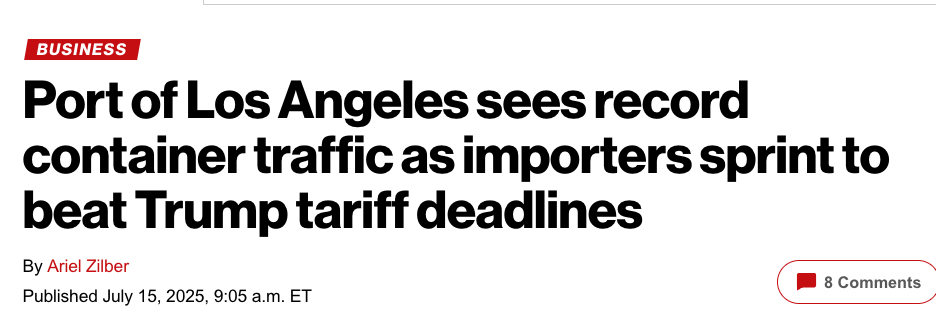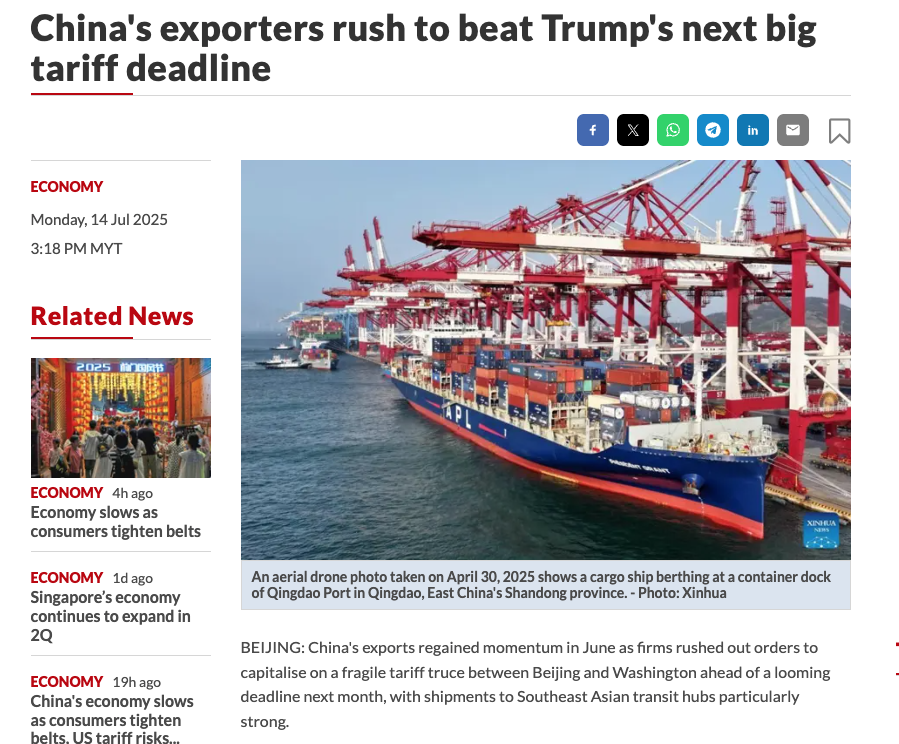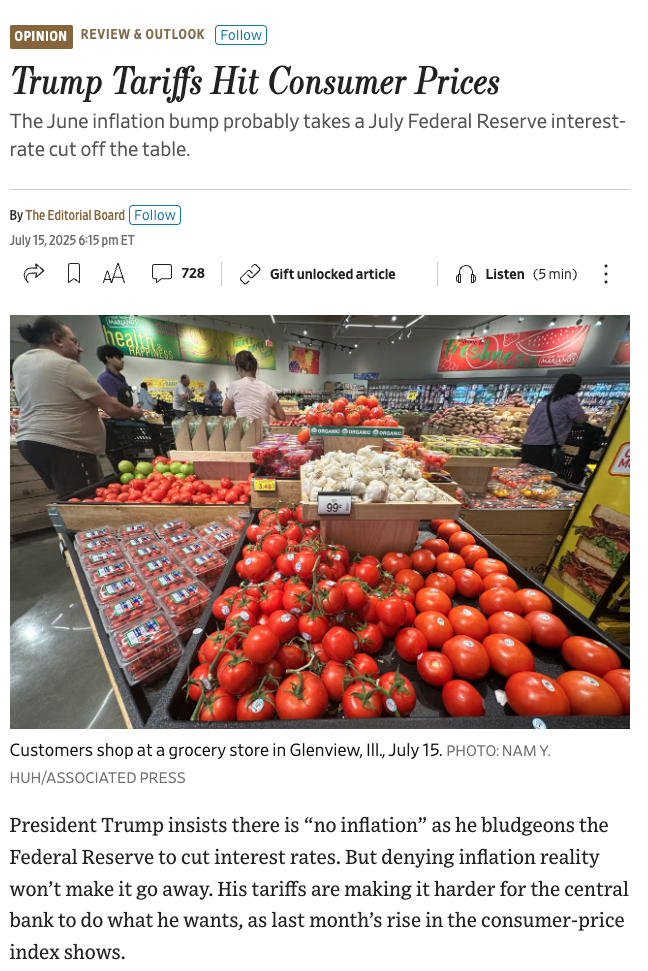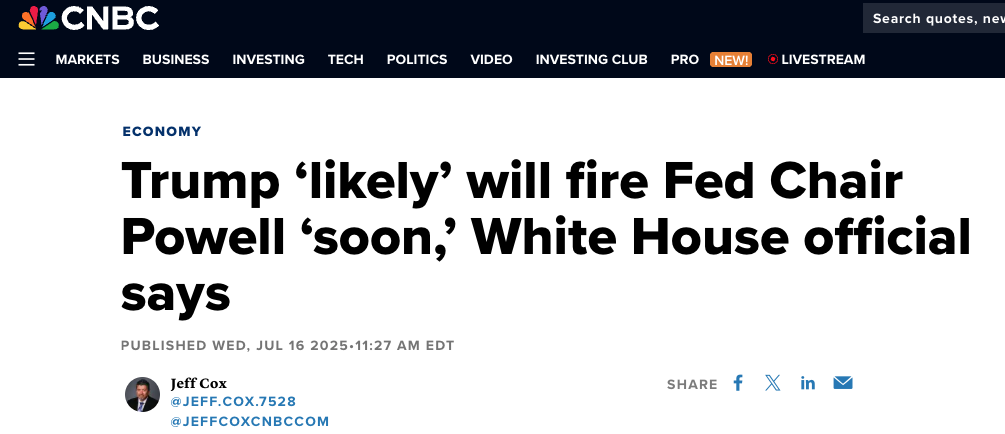
Lets Get Real About Tariffs
Wall Street seems to be convinced that tariffs aren’t going to contribute to rising inflation, they won’t do any damage to the economy, they will be easily absorbed, and all will be well in the world. Based on how the stock market has reacted the past couple of months that should be easy to believe. It would be fantastic if it turns out to be true, but I’ve had nagging doubts for months.
If tariffs are so good for the U.S. why can’t the President tell the truth about what they are?
Trump has framed tariffs as a tax paid by foreign exporters, and evidently a lot of Americans believe him. Just to do a little fact checking here are a few quotes from him.
- “We’re going to be a tariff nation. It’s not going to be a cost to you. It’s going to be a cost to another country.”
Said at a Wisconsin rally in September (during the 2024 campaign). Wikipedia+12FactCheck.org+12Axios+12 - “I’m not raising your taxes. I’m raising China and all of these countries in Asia and all over the world … and they’re going to have to pay a price now…”
Same rally, further reiterating his position. FactCheck.org - “Instead of taxing our citizens to enrich other countries, [we] will tariff and tax foreign countries to enrich our citizens.”
Declared during his inaugural address for a second term on January 20, 2025. FactCheck.org+14Wikipedia+14U.S. News & World Report+14
Nothing could be further from the truth. Tariffs on imported goods are paid by the importer of record, here in the United States. In the unlikely case that a foreign company or government is shipping goods to itself, it will pay the tariff. But in the much more likely case that it is shipping goods to an American company, the American company will pay the tariff at the port of entry. They must pay before the shipment will be released to them. The payments go to the U.S. Customs and Border Protection (CBP) agency, operated by the Department of Homeland Security, and ultimately to the U.S. Treasury. Therefore Trump is correct when he says that government revenues will increase a lot under this tariff regime. But that money is coming out of the pockets of American importers. We will not “tariff and tax foreign countries to enrich our citizens”! Let’s get real about the tariffs. They are a tax on American importers.
The importer may choose to absorb the tariff and therefore reduce their profit margin. They may choose to absorb part, and pass part onto their customers, therefore sharing the cost with their customers. They may also pass the entire tariff onto their customers, who then pay even higher prices. Rest assured, no one from the country where the goods came from pay the tariff, unless they shipped to themselves!!
The rules on when and how tariffs are applied are way too complicated to detail in this letter. The current U.S. Customs manual is several hundred pages long. For the purposes of this letter, you only need to understand that most tariff impact has not yet hit the real economy. Exporters and shippers all over the world have been racing to get goods to the United States before the tariffs take effect. Simply stated, we haven’t yet felt the cost of most of the tariffs.


Despite best efforts to get goods to the United States before the full tariff impact is felt, customs duties (tariffs) are rising. In June 2025 the U.S. Treasury collected $27 billion in customs revenue (tariffs), $20 billion more than a year ago. (Source: Wall Street Journal, July 14, 2025) That would all be fine and dandy except that it's being paid by U.S. companies while Trump is telling us that it’s being paid by the exporters!!!
Now you may ask, “Who cares?” U.S. companies benefited from extensions of huge tax breaks in the Big Beautiful Bill (BBB). That is true. But don’t kid yourself. All the money that flows into the U.S. Treasury from tariffs is a wealth transfer from the private sector to the public sector. A tariff is a tax, “and when you tax something you get less of it”. Tariffs can restrain trade and drive up prices. Some portion of that rise in price is getting passed on to you. The Wall Street Journal reports… “domestic producers will also take advantage of the tariffs to raise prices. This is what happened after Mr. Trump slapped tariffs on washing machines in his first term. While imports fell by a third in the year after the tariffs took effect, prices rose 12% for washers and dryers.”
What is Trump’s real intention regarding tariffs?
We’ve all been guessing whether Trump intends to keep tariffs in place or is just using them as a bargaining tool. It’s seeming more likely that he intends to keep them in place. If income to the Treasury stays at June 2025 levels and is annualized, about $325 billion per year would be available to offset debt. Or, it could be invested in the U.S. economy to assist in bringing critical manufacturing back to the U.S.
Just a few days ago, the Department of Defense (DOD) made a $400 million equity investment and provided a $150 million loan to MP Materials, a publicly traded company that is “at the center of U.S. strategic efforts to re-establish a domestic rare-earth supply chain.” Continuous revenues from tariffs could give Trump the source of capital he needs to create a sovereign wealth fund which provides capital to companies, projects, and industries of strategic importance to the U.S.
Truth be told, we still don’t know what the total impact of the tariffs will be. We may not for a while. Some mock the President by calling him TACO (Trump Always Chickens Out). The President defends himself by calling it “negotiation”. Financial Times reported Tuesday morning “Donald Trump reaps $50 billion tariff haul as world chickens out. America’s trading partners have largely failed to retaliate…allowing a president taunted for always chickening out to raise nearly $50 billion in extra customs revenues at little cost”.
So far only China and Canada have retaliated in any way. Despite aiming for 90 deals in 90 days as of early July 2025, only a few have been announced. Two are with Indonesia and Vietnam. A “mini-trade deal” has been made with the United Kingdom. A “framework deal” was announced with China. We can expect updates as the August 1st deadline looms.
Copper tariffs are especially confusing.
I’m very skeptical about the 50% tariff on imported copper and frankly think it’s a mistake. Trump’s stated motive is to increase domestic production of copper, which I agree should happen. Here is some background on the subject.
- In February 2025, Trump initiated a Section 232 investigation, arguing that high U.S. dependence on foreign copper posed a national security risk.
The Times of India+15U.S. News+15Bloomberg.com+15. - Copper is vital to defense (radar, missile systems, hypersonic weapons, ammunition) and critical infrastructure (semiconductors, batteries, electric grid).
CBS News+2Reuters+2The Economic Times+2. - The U.S. currently imports about 45–53% of its refined copper; the tariff aims to rebuild domestic mining and processing capacity, reducing reliance on countries like China, Chile, Canada, and Mexico.
The only problem is that new copper production in the United States is projected to be at least 5 years away, by none other than Jakob Stausholm, CEO of Rio Tinto. (Stausholm was interviewed Tuesday by Bloomberg) Rio Tinto happens to control the biggest proposed copper mining project in the United States. In the meantime, copper prices have skyrocketed as a result of the 50% tariff proposed on July 9, 2025, with an effective date of August 1, 2025.
On July 14, 2025 the Wall Street Journal reported, "More expensive copper will boost the cost of making everything from automobiles to electronics as well as building houses. There are hundreds of pounds of copper in the typical American home between electrical wiring, plumbing and appliances. The average car contains nearly a mile of copper wiring alone."
In a social-media post Wednesday night, Trump cited copper’s use in semiconductors, aircraft, ships, ammunition, radar systems and other military assets as reason for the tariff.
“Copper is the second most used material by the Department of Defense!” the President wrote. “America will, once again, build a DOMINANT Copper Industry.”
I agree with the President on the need to develop more copper mining in the United States. But why raise prices five years before significant new production can come online? Rio Tinto, and others, were already making progress on opening new mines. Why not help them clear out some of the regulatory hurdles that are holding them up, rather than raising the price of this vital metal? The 50% tariff, years before we have new production, makes no sense to me. Any tariff, years before we have new production, also makes no sense to me.
The U.S. imported around 1 million metric tons of refined copper in 2024, covering nearly half of our total consumption. That copper comes from Peru (70%), Canada (17%), Peru (7%), Democratic Republic of the Congo (2-3%) and Mexico (1-2%). The U.S. also buys copper ore and copper scraps, primarily from Canada and Mexico. None of those countries are going to pay the tariffs! U.S. buyers will pay the tariffs, for the next several years until we can ramp up domestic production. Please explain how that makes any sense.
The Fed might have cut interest rates if not for the tariffs. Lesson to President Trump, “Don’t Fight the Fed”
In 1970, renowned investor Martin Zweig coined the phrase “Don’t Fight the Fed” and it has been gospel for investment managers ever since. Blackrock Wealth Management states, “This phrase underscores the idea that when the Federal Reserve aims to stimulate the economy, reduce inflation, or increase employment, it has the necessary tools to achieve these goals. Historical evidence supports this notion.”
President Trump “fights the Fed” every day, both by disparaging Chair Jerome Powell and raising prices through tariffs.

We all know that the President will replace Powell at the end of his term in May 2026. In fact, while I was drafting this newsletter yesterday, this headline appeared.

The President denied this almost as soon as the headline appeared, But this morning (Thursday, July 17, 2025) the New York Times is reporting that “Trump has actually drafted a letter for Powell’s dismissal."
J.P. Morgan’s chief U.S. economist, Michael Feroli, is warning, “Any reduction in the independence of the Fed would likely add upside risks to an inflation outlook that is already subject to upward pressures from tariffs and somewhat elevated inflation expectations. Moreover, market participants could demand greater compensation for inflation and inflation risks, thereby increasing longer-term interest rates, weighing on the outlook for economic activity, and worsening the fiscal position.” (Source: CNBC.com)
Undoubtedly, any new Fed Chair will be required to acquiesce to the President’s will, reminiscent of Arthur Burns relationship with President Nixon in the 1970’s. Burn’s tenure as Fed chief was a disaster in many ways, and he never lived it down. For those of you not familiar with Burn’s term as Chair of the Fed, here is a little history from ChatGPT 4o:
Background Context: Arthur Burns and Richard Nixon
Arthur Burns was the Chairman of the Federal Reserve from 1970 to 1978, appointed by President Richard Nixon. Burns was a respected economist and a former adviser to Nixon. Their relationship was personal and political: Nixon saw Burns as a key figure to help ensure economic conditions that would support Nixon's re-election in 1972.
At the time, inflation was rising, and Nixon was deeply concerned about the political consequences of tight monetary policy leading to a recession before the election. Nixon’s approach to economic policy included considerable pressure on Burns and the Fed.
Did Burns Acquiesce to Nixon’s Will?
The short answer: Yes, to a significant extent, Burns did acquiesce to Nixon’s wishes, though not without some internal conflict and reservations. Here’s a breakdown:
Political Pressure and Personal Manipulation
- Nixon was notorious for applying direct pressure on Burns. Taped conversations from the Nixon White House (later revealed in the Watergate investigations) show Nixon berating Burns and insisting that the Fed pursue a loose monetary policy to stimulate the economy before the 1972 election.
- Nixon saw monetary policy as a tool for electoral gain and made it clear to Burns that he expected cooperation.
Burns’ Policy Response
- In the early 1970s, the Fed under Burns did pursue an expansionary policy: it kept interest rates low and increased the money supply, contributing to short-term economic growth and low unemployment, which helped Nixon politically.
- However, this policy came at a long-term cost, exacerbating inflationary pressures that became central to the 1970s "stagflation" crisis.
Burns’ Justification
- Burns was not simply Nixon’s puppet; he struggled with his responsibilities as an independent central banker and his loyalty to Nixon.
- In his later writings and speeches, Burns expressed regret over the period, acknowledging the inflationary consequences of his accommodative stance, but he also defended his actions as having been constrained by the political environment, wage-price controls, and international pressures (especially after Nixon ended the Bretton Woods system in 1971).
Historical Interpretation
- Many historians and economists interpret Burns’ tenure as an example of a Fed compromised by political interference.
- The episode is one reason why subsequent reforms reinforced the Federal Reserve's independence from the White House.
Conclusion
In summary: Arthur Burns did acquiesce to Nixon’s will, implementing a loose monetary policy that suited Nixon’s political needs, despite his understanding of the risks. Burns faced extraordinary pressure from Nixon personally, and his response has been widely criticized as contributing to the inflation of the 1970s and undermining the Fed’s credibility.
This period is now often cited as a cautionary tale about the dangers of political interference in central banking and is part of the reason the principle of Federal Reserve independence is so strongly emphasized today.
We continue to move further and further into uncharted territory. In the meantime, markets seem perfectly sanguine. Martin Zweig had another favorite phrase, it was "don't fight the tape."
Paul Krsek
CEO
5T Wealth, LLC
Main (707) 224-1340
595 Coombs St
Napa, CA 94559
Disclosure and Disclaimer - Updated last on March 20, 2024 by Paul Krsek:
ELLUMINATION is the proprietary newsletter written for clients, friends, and affiliates of 5T WEALTH, LLC (5T), which is an SEC registered investment advisor. Information presented is for educational purposes only. The information does not intend to make an offer or solicitation for the sale or purchase of any specific securities, investments, or investment strategies. Investments involve risk and are not guaranteed. 5T has reasonable belief that this letter does not include any false or material misleading statements or omissions of facts regarding services or investments. 5T has reasonable belief that the content as a whole will not cause an untrue or misleading implication regarding the adviser’s services, investments, or client experiences.
The opinions expressed are those of the author and are subject to change without notice. The opinions referenced are as of the date of publication and are subject to change due to changes in the market or economic conditions and may not necessarily come to pass. Any opinions, projections, or forward-looking statements expressed herein are solely those of the author. They may differ from the views or opinions expressed by other areas of 5T and are only for general informational purposes as of the date indicated.
5T has presented information in a fair and balanced manner. 5T is not giving tax, legal, or accounting advice.
Past performance should not be considered an indicator of potential future performance. If you do not consider yourself suitable, either emotionally or financially, to experience volatility and/or losses in financial markets, you should not invest. The portfolio managers at 5T do not guarantee investment results.
Charts, displays and graphs may be used as illustrations. They are not intended to be used by themselves to determine which securities to buy or sell, or when to buy or sell them. Such charts and graphs offer limited information and can’t be used on their own to make investment decisions.
ELLUMINATION does not represent the opinions of Fidelity, Fidelity Institutional Brokerage Group, NFS or anyone employed by Fidelity in any capacity. Neither Fidelity, Fidelity Institutional Brokerage Group, nor NFS, nor anyone employed by Fidelity in any capacity has participated in the creation of ELLUMINATION and they are not responsible for the contents or distribution of ELLUMINATION.
ELLUMINATION does not represent the opinions of Charles Schwab Corporation, Schwab Advisor Services or anyone employed by Schwab in any capacity. Neither Charles Schwab Corporation nor Schwab Advisor Services, nor anyone employed by Schwab in any capacity has participated in the creation of ELLUMINATION and they are not responsible for the contents or distribution of ELLUMINATION.
The investment objectives of various strategies mentioned in ELLUMINATION may be substantially different from one another. Therefore topics or investments mentioned in ELLUMINATION may or may not apply to specific managed accounts and/or strategies. If you are unsure which strategies your accounts are invested in please ask a representative of 5T to clarify that for you.
The assets held in managed accounts at 5T may include stocks, bonds, cash, commodities, foreign exchange, mutual funds or exchange traded funds (ETF's), money market accounts or limited partnerships that represent the same. They are subject to market fluctuation and the potential for losses. The assets are not insured. The value and income produced by these investment products may fluctuate, so that an investor may get back less than they initially invested.

